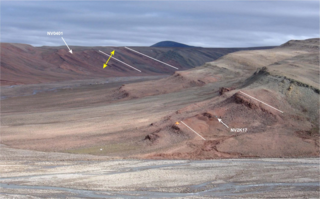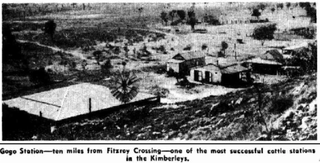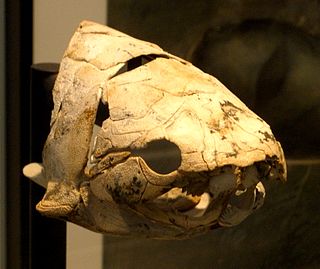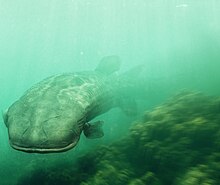
Panderichthys is a genus of extinct sarcopterygian from the late Devonian period, about 380 Mya. Panderichthys, which was recovered from Frasnian deposits in Latvia, is represented by two species. P. stolbovi is known only from some snout fragments and an incomplete lower jaw. P. rhombolepis is known from several more complete specimens. Although it probably belongs to a sister group of the earliest tetrapods, Panderichthys exhibits a range of features transitional between tristichopterid lobe-fin fishes and early tetrapods. It is named after the German-Baltic paleontologist Christian Heinrich Pander. Possible tetrapod tracks dating back to before the appearance of Panderichthys in the fossil record were reported in 2010, which suggests that Panderichthys is not a direct ancestor of tetrapods, but nonetheless shows the traits that evolved during the fish-tetrapod evolution

Holoptychius is an extinct genus of porolepiform lobe-finned fish from the Middle Devonian to Carboniferous (Mississippian) periods. It is known from fossils worldwide. The genus was first described by Louis Agassiz in 1839.

The Fram Formation is an Upper Devonian (Frasnian) sequence of rock strata on Ellesmere Island that came into prominence in 2006 with the discovery in its rocks of examples of the transitional fossil, Tiktaalik, a sarcopterygian or lobe-finned fish showing many tetrapod characteristics. Fossils of Laccognathus embryi, a porolepiform lobe-finned fish, and Qikiqtania, a close relative of Tiktaalik, were also found in the formation. The Fram Formation is a Middle to Upper Devonian clastic wedge forming an extensive continental facies consisting of sediments derived from deposits laid down in braided stream systems that formed some 375 million years ago, at a time when the North American craton ("Laurentia") was straddling the equator.

The Gogo Formation in the Kimberley region of Western Australia is a Lagerstätte that exhibits exceptional preservation of a Devonian reef community. The formation is named after Gogo Station, a cattle station where outcrops appear and fossils are often collected from, as is nearby Fossil Downs Station.

Holonema is an extinct genus of relatively large, barrel-shaped arthrodire placoderms that were found in oceans throughout the world from the Mid to Late Devonian, when the last species perished in the Frasnian-Fammian extinction event. Most species of the genus are known from fragments of their armor, but the Gogo Reef species, H. westolli, is known from whole, articulated specimens.

Holoptychiidae is an extinct family of lobe-finned fishes which lived during the Devonian period. At least one genus, Laccognathus, is thought to have been amphibious.

Eastmanosteus is a fossil genus of dunkleosteid placoderms. It was closely related to the giant Dunkleosteus, but differed from that genus in size, in possessing a distinctive tuberculated bone ornament, a differently shaped nuchal plate and a more zig-zagging course of the sutures of the skull roof.

Laccognathus is an extinct genus of amphibious lobe-finned fish from Europe and North America. They existed from the Middle Devonian to the Late Devonian. The name comes from Greek for 'pitted jaw'.

Plourdosteus is an extinct genus of placoderm arthrodire which was relatively widespread in Euramerica during the Givetian to Frasnian ages of the Devonian. It was a small placoderm, with P. canadensis measuring 37.5–51.4 cm (14.8–20.2 in) long.

Laccognathus embryi is an extinct species of porolepiform lobe-finned fish recovered from Ellesmere Island, Canada. It existed during the Frasnian age of the Late Devonian epoch.
Laccognathus grossi is an extinct lobe-finned fish from eastern Europe. They existed during the Middle Devonian. The species is named after Walter Gross, who collected the first Laccognathus fossils belonging to L. panderi.

The Gauja Formation is a Middle Devonian fossil locality in Estonia and Latvia. It is named after the Gauja River, where it is exposed along the banks.
This list of fossil fish species is a list of taxa of fish that have been described during the year 2012. The list only includes taxa at the level of genus or species.

Asterolepis is an extinct genus of antiarch placoderms from the Devonian of North and South America and Europe. They were heavily armored flat-headed benthic detritivores with distinctive jointed limb-like pectoral fins and hollow spine. The armor plate gives the Asterolepis a box-like shape. Its pectoral fins are also armored but the caudal and dorsal fin are not. The first fossils were named by M. Eichwald in 1840 after noticing star-like markings on the fossils.

Ptyctodus is an extinct armour-plated fish of the late Devonian. Ptyctodus belongs to the family Ptyctodontidae and is of the class Placodermi. They share a close resemblance to modern day chimaeras (Holocephali). Fossils of this armour-plated fish have been found in locations such as in Russia, the Michigan Basis, and Arizona, United States.
Soligorskopterus is a genus of eurypterid, a group of extinct aquatic arthropods. Fossils of Soligorskopterus have been discovered in deposits from the Late Devonian. The genus contains two species: S. tchepeliensis, the type species, from the Middle Famennian stage of Belarus, and S. shpinevi, from the Lower Frasnian stage of Russia. Its name derives from Soligorsk, the closest city from the fossil site of the type species, and the Greek word πτερόν (pteron), which means wing.

Phoebodus is an extinct genus of phoebodontiform elasmobranch, known from over a dozen species found worldwide spanning the middle to late Devonian. Most species are only known from their isolated tricuspid teeth, but one species, Phoebodus saidselachus from the Late Devonian of Morocco, is known from a complete skeleton, estimated to have been 1.2 metres in total length in life, which shows that it had a slender body superficially similar to that of the living frilled shark. The teeth of Phoebodus and frilled sharks are also morphologically similar, and are designed for grasping prey. Phoebodus probably consumed small prey items that were capable of being swallowed whole.
Tartuosteus is an extinct genus of jawless fish from the Devonian of Eastern Europe. It is notable for its large size in comparison to other Ostracoderms, reaching a width of 1.5 m (4.9 ft).














